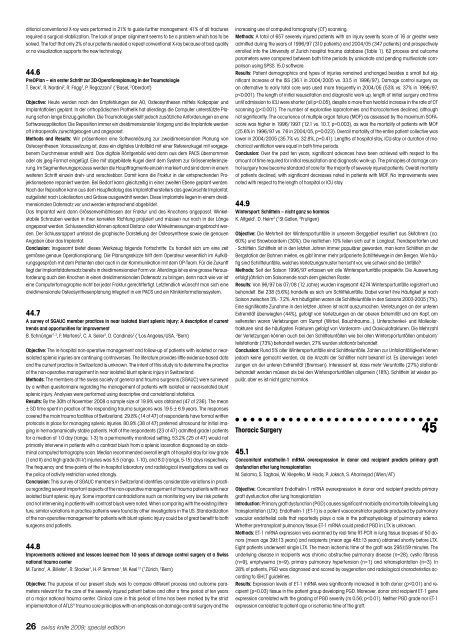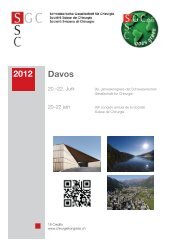Abstracts - Chirurgie Kongress
Abstracts - Chirurgie Kongress
Abstracts - Chirurgie Kongress
Create successful ePaper yourself
Turn your PDF publications into a flip-book with our unique Google optimized e-Paper software.
ditional conventional X-ray was performed in 21% to guide further management. 41% of all fractures<br />
required a surgical stabilization. The lack of proper alignment seems to be a problem which has to be<br />
solved. The fact that only 2% of our patients needed a repeat conventional X-ray because of bad quality<br />
or no visualization supports the new technology.<br />
44.6<br />
PreOPlan – ein erster Schritt zur 3D-Operationsplanung in der Traumatologie<br />
T. Beck 1 , R. Nardini 2 , R. Frigg 2 , P. Regazzoni 1 ( 1 Basel, 2 Oberdorf)<br />
Objective: Heute werden nach den Empfehlungen der AO, Osteosynthesen mittels Kalkpapier und<br />
Implantatfolien geplant. In der orthopädischen Prothetik hat allerdings die Computer unterstützte Planung<br />
schon lange Einzug gehalten. Die Traumatologie stellt jedoch zusätzliche Anforderungen an eine<br />
Softwareapplikation: Die Reposition immer ein dreidimensionaler Vorgang und die Implantate werden<br />
oft intraoperativ zurechtgebogen und angepasst.<br />
Methods and Results: Wir präsentieren eine Softwarelösung zur zweidimensionalen Planung von<br />
Osteosynthesen: Voraussetzung ist, dass ein digitales Unfallbild mit einer Referenzkugel mit vorgegebenem<br />
Durchmesser erstellt wird. Das digitale Röntgenbild wird dann aus dem PACS übernommen<br />
oder als jpeg-Format eingefügt. Eine mit abgebildete Kugel dient dem System zur Grössenreferenzierung.<br />
Im Segmentierungsprozess werden die Hauptfragmente einzeln markiert und sind dann in einem<br />
weiteren Schritt einzeln dreh- und verschiebbar. Damit kann die Fraktur in der entsprechenden Projektionsebene<br />
reponiert werden. Bei Bedarf kann gleichzeitig in einer zweiten Ebene geplant werden.<br />
Nach der Reposition kann aus dem Hauptkatalog des Implantatherstellers das gewünschte Implantat,<br />
aufgelistet nach Lokalisation und Grösse ausgewählt werden. Diese Implantate liegen in einem dreidimensionalen<br />
Datensatz vor und werden entsprechend abgebildet.<br />
Das Implantat wird dann Grössenverhältnissen der Fraktur und des Knochens angepasst. Winkelstabile<br />
Schrauben werden in ihrer korrekten Richtung projiziert und müssen nur noch in der Länge<br />
angepasst werden. Schlussendlich können optional Distanz- oder Winkelmessungen angebracht werden.<br />
Der Schlussrapport umfasst die graphische Darstellung der Osteosynthese sowie die genauen<br />
Angaben über das Implantat.<br />
Conclusion: Insgesamt bietet dieses Werkzeug folgende Fortschritte: Es handelt sich um eine zeit<br />
gemässe genaue Operationsplanung. Die Planungsskizze hilft dem Operateur wesentlich im Aufklärungsgespräch<br />
mit dem Patienten aber auch in der Kommunikation mit dem OP-Team. Für die Zukunft<br />
liegt der Implantatdatensatz bereits in dreidimensionaler Form vor. Allerdings ist es eine grosse Herausforderung<br />
auch den Knochen in einen dreidimensionalen Datensatz zu bringen, denn nach wie vor ist<br />
eine Computertomographie nicht bei jeder Fraktur gerechtfertigt. Letztendlich wünscht man sich eine<br />
dreidimensionale Osteosynthesenplanung integriert in ein PACS und ein Klinikinformationssystem.<br />
44.7<br />
A survey of SGAUC member practices in near isolated blunt splenic injury: A description of current<br />
trends and opportunities for improvement<br />
B. Schnüriger 1, 2 , F. Martens 2 , C. A. Seiler 2 , D. Candinas 2 ( 1 Los Angeles/USA, 2 Bern)<br />
Objective: The in-hospital non-operative management and follow-up of patients with isolated or nearisolated<br />
splenic injuries are continuing controversies. The literature provides little evidence-based data<br />
and the current practice in Switzerland is unknown. The intent of this study is to determine the practice<br />
of the non-operative management in near isolated blunt splenic injury in Switzerland.<br />
Methods: The members of the swiss society of general and trauma surgeons (SGAUC) were surveyed<br />
by a written questionnaire regarding the management of patients with isolated or near-isolated blunt<br />
splenic injury. Analyses were performed using descriptive and correlational statistics.<br />
Results: By the 30th of November 2008 a sample size of 19.9% was obtained (47 of 236). The mean<br />
± SD time spent in practice of the responding trauma surgeons was 19.5 ± 6.9 years. The responses<br />
covered the main trauma facilities of Switzerland. 29.8% (14 of 47) of respondents have formal written<br />
protocols in place for managing splenic injuries. 80.9% (38 of 47) preferred ultrasound for initial imaging<br />
in hemodynamically stable patients. Half of the respondents (23 of 47) admitted grade I patients<br />
for a median of 1.0 day (range, 1-3) to a permanently monitored setting. 53.2% (25 of 47) would not<br />
primarily intervene in patients with a contrast blush from a splenic laceration diagnosed by an abdominal<br />
computed tomography scan. Median recommended overall length of hospital stay for low grade<br />
(I and II) and high grade (III-V) injuries was 5.5 (range, 1-10), and 8.0 (range, 5-15) days respectively.<br />
The frequency and time-points of the in-hospital laboratory and radiological investigations as well as<br />
the policy of activity restriction varied strongly.<br />
Conclusion: This survey of SGAUC members in Switzerland identifies considerable variations in practice<br />
regarding several important aspects of the non-operative management of trauma patients with near<br />
isolated blunt splenic injury. Some important contradictions such as monitoring very low risk patients<br />
and not intervening in patients with contrast blush were noted. When comparing with the existing literature,<br />
similar variations in practice patterns were found by other investigators in the US. Standardization<br />
of the non-operative management for patients with blunt splenic injury could be of great benefit to both<br />
surgeons and patients.<br />
44.8<br />
Improvements achieved and lessons learned from 10 years of damage control surgery at a Swiss<br />
national trauma center<br />
M. Turina 1 , A. Billeter 1 , R. Stocker 1 , H.-P. Simmen 1 , M. Keel 1,2 ( 1 Zürich, 2 Bern)<br />
Objective: The purpose of our present study was to compare different process and outcome parameters<br />
relevant for the care of the severely injured patient before and after a time period of ten years<br />
at a major national trauma center. Clinical care in this period of time has been marked by the strict<br />
implementation of ATLS ® trauma care principles with an emphasis on damage control surgery and the<br />
26 swiss knife 2009; special edition<br />
increasing use of computed tomography (CT) scanning.<br />
Methods: A total of 657 severely injured patients with an injury severity score of 16 or greater were<br />
admitted during the years of 1996/97 (310 patients) and 2004/05 (347 patients) and prospectively<br />
enrolled into the University of Zurich hospital trauma database (Table 1). 62 process and outcome<br />
parameters were compared between both time periods by univariate and pending multivariate comparison<br />
using SPSS 15.0 software.<br />
Results: Patient demographics and types of injuries remained unchanged besides a small but significant<br />
increase of the ISS (36.1 in 2004/2005 vs. 33.5 in 1996/97). Damage control surgery as<br />
an alternative to early total care was used more frequently in 2004/05 (53% vs. 37% in 1996/97,<br />
p



